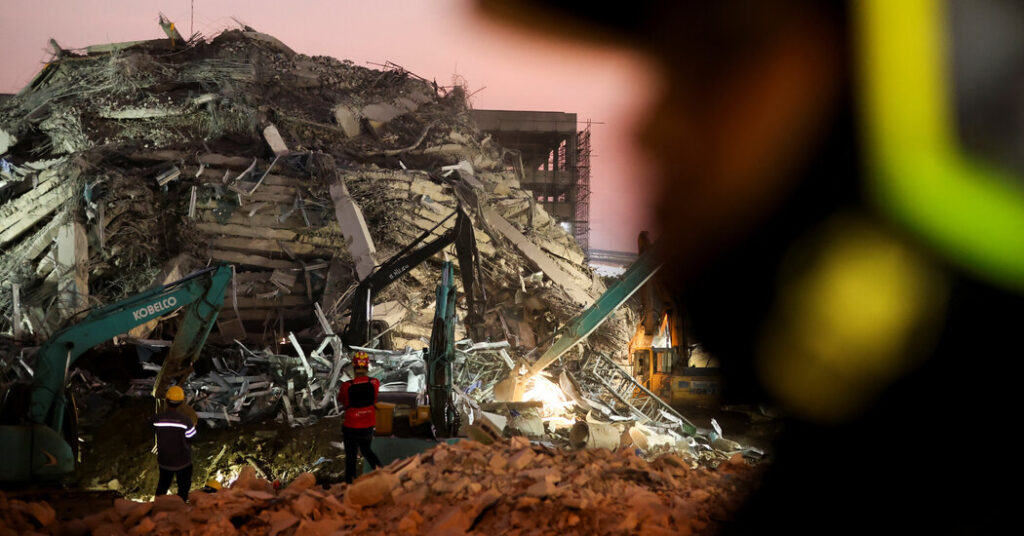Aubonrat Setnawet, an electrician’s helper, was working with her husband on the 23rd floor of a new office tower on the northern edge of Bangkok moments before disaster struck.
She needed to get some equipment, so she took the construction elevator to the ground floor. Suddenly, she felt the ground sway beneath her and, with two sharp cracking sounds, the unfinished building began to collapse.
With her cellphone in hand, she ran to escape the falling debris as a huge dust cloud rose. She tried calling her husband, Nuguy Setnawet, an electrician, but her calls did not go through.
Since then, she has remained at the site, watching quietly as rescuers search for survivors. The news has been grim. Eight bodies were recovered from the scene on Friday but only one on Saturday.
“I am still here waiting, waiting for a miracle,” Ms. Aubonrat said.
About 80 people believed to have been in the 30-story building at the time of the collapse remain unaccounted for.
Rescuers using heavy equipment and canine search teams spotted only the one body during the search on Saturday. The pile of rubble — seven stories high — is so unstable that it took them hours to recover the body.
That brought to 10 the number of known fatalities in Bangkok from the quake, including a crane operator who fell to his death from a different building under construction.
The epicenter of the quake was more than 600 miles to the north near Mandalay, Myanmar’s second largest city, where the devastation was far worse. More than 1,600 were reported dead and the number is expected to rise considerably.
At the site of the collapsed Bangkok building, the search continued into the evening under bright lights. Heavy equipment operators moved large chunks of metal from the rubble in the hope of finding survivors.
Hundreds of rescuers from the military, the police and volunteer groups helped with the search. Dozens of relatives and friends of the missing workers watched from behind a barrier.
In addition to search dogs, rescue teams used heat sensors to try to detect people who were still alive.
Periodically, all work stopped so the searchers could listen for the sounds of survivors. But by Saturday evening, they had not heard any cries of help from within the mountain of debris.
Piyalux Thinkaew, a rescuer from the Ruamkatanyu Foundation, said heavy equipment that arrived Saturday was being used to clear away large pieces of metal and concrete while workers tried carefully not to destabilize the mountain of debris.
“This is to open a path for us to be able to see underneath and check for any signs of life,” he said. “It’s a very difficult task and it’s risky work for the rescuers as well.”
Suchatvee Suwansawat, a professor of civil engineering at King Mongkut University and a former president of the Council of Engineers Thailand, said experts must determine whether the collapse was caused by a design flaw or a construction error.
An unfinished building should be in no more danger of collapsing during an earthquake than a completed structure, he said.
“It has to be 100 percent safe,” he said. “There was something wrong. This is like the building exploded. It’s not normal.”
He said Thailand had never experienced the collapse of a building this size. Previously, he said, two six-story buildings collapsed, one in 2014 and one in 1993.
“We really have no experience with this,” he said. “We cannot say much yet because we have to look at the calculations and collect samples and evidence. Everything collapsed at the same time. And from the video, we saw the columns burst.”
The building was to be an officer tower for Bangkok’s auditor-general.
A Chinese state-owned company, the China Railway 10th Engineering Group, was part of a consortium awarded the contract to build the high-rise, according to an article in the People’s Daily, the Chinese Communist Party’s mouthpiece, that was published in 2021. The consortium also included a Bangkok-based builder, Italian-Thai Development Plc.
Neither company could be immediately reached for comment.
The project, which broke ground in April 2021, was one of the tallest buildings China Railway 10th Engineering Group had constructed, the People’s Daily said at the time.
The company is a subsidiary of state-owned giant, China Railway Group, which is heavily involved in China’s Belt and Road Initiative, a global infrastructure project intended to deepen China’s supply chain networks and expand the country’s influence.
Among those waiting at the site for word of their missing relatives was Saifon Thongsuk, 36, whose aunt and uncle and two adult children were all working on the office tower.
They had been working at a different construction project on Bangkok’s outskirts but had recently been sent to the site because of an urgent need for workers, she said.
“I don’t know how long they had been working here,” she said. “I only know they were working on the top floor.”
Naruemol Thonglek, 44, came to the site seeking word of six people including her husband, his son and four co-workers.
Ms. Naruemol had been working at the site, too, until recently, but quit because her husband worried that it was leaving her too exhausted.
“I rushed here as soon as I heard about the earthquake,” she said. “I tried to get hold of him. Messages were not delivered. Calls were not connected. I cannot contact any of them.”
She continued, “I guess he is in the middle of that pile of rubble. Maybe there’s some space for air, I don’t know. I can only hope for miracles.”
Thurian Pheungrod, 47, also hurried to the site on Friday after learning that his brother and sister-in-law were buried in the collapsed building. They had been working at the site for several months.
“At first, I still believed there could be a miracle,” he said. “I still had hope. But I don’t hope for miracles anymore.”
Berry Wang and David Pierson contributed reporting from Hong Kong.
https://www.nytimes.com/2025/03/29/world/asia/bangkok-building-collapse.html


